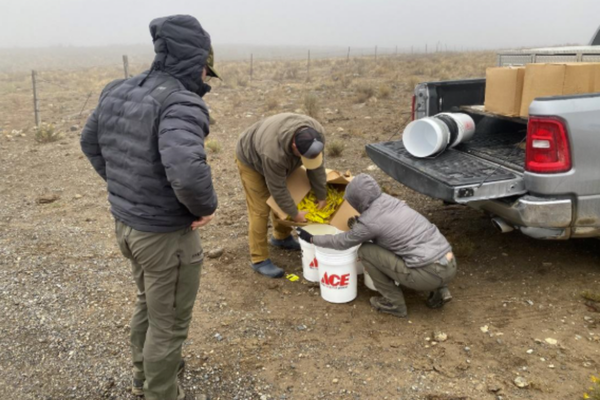Sage Grouse in the Schools
During the cool, early morning hours in the sagebrush hills north of I-85, I scanned my eyes left and right across the dimly lit landscape to find what we were searching for. My car rolled slowly down the southern Idaho dirt road, wildlife biologist Josh White in the passenger seat glancing out at the sagebrush looking for the same. Behind us followed a school bus full of high school kids from the towns of Bliss and Hagerman. Suddenly a huge bird appeared on the road in front of my car, two more behind it. We’d found the lek. Engines were turned off, binoculars were distributed and a school bus full of teenagers with smart phones and energy drinks was, for a bit of time, quiet. The early morning light coming over the horizon gave the group its first glimpse at the dozens of Greater sage grouse standing tall in an opening among the sagebrush, their white breasts a sharp contrast to the muted colors of the earth around them.
A student watches sage grouse on the lek through a spotting scope.
The Greater sage-grouse is a resilient species, living their lives in some of the most extreme cold and intense heat that Idaho has to throw at them. Despite this resiliency, the birds’ success is entirely dependent upon one thing: sagebrush.
Sagebrush is a long-lived shrub, some plants reaching well over 100 years old. In a healthy sagebrush steppe ecosystem, you’ll find a variety of age classes of plants and a rich tapestry of grasses and forbs that provide food for a wide range of wildlife species – from iconic pronghorn and mule deer, to migrating song birds and pygmy rabbits. While at first glance this ecosystem may appear monotonous and dull, there is an abundance of life and many species found within the “sagebrush sea”, including the Greater sage grouse, are considered sagebrush obligate species meaning their lifecycles depend on this important ecosystem.
The canary in the coal mine of the sagebrush steppe ecosystem, Greater sage-grouse are considered an umbrella species, meaning their needs are directly correlated to those of dozens of other species that depend on the same habitat. Major threats to this habitat include fire and development, both of which are contributing to a decline in Greater sage grouse across their range. As their numbers have decreased over the years, the question has been brought forward as to how to ensure their success and keep the birds off the Endangered Species List. The question, while raising concerns, has motivated a range of stakeholders to collaborate on the issue including biologists, land managers, ranchers, elected officials and a other stakeholders. With a fraction of species ever being successfully recovered from the ESA, a listing would not only mean serious trouble for the birds and other sagebrush steppe species, but also for people like Idaho’s ranchers and farmers who live their lives alongside these iconic birds.
A male Greater sage grouse. Photo: McEwan
The US Fish and Wildlife Service has partnered with Idaho Department of Fish and Game and other stakeholders to establish a unique program titled “Sage Grouse in the Schools”, aimed at teaching Idaho high schoolers about the diverse lands and characters behind sage grouse conservation in Idaho. While living just a short drive from the lek we were watching that morning, most of the kids had never laid eyes on a sage grouse before and they took turns peering through the school bus windows at the impressive display outside.
Male sage grouse congregate on a lek with cattle grazing in the background.
We continued to watch the birds that morning until they began to disperse from the lek, back to the sagebrush until dusk when the courtship dance would begin all over again. Vehicles began driving down south out of the hills and towards town. Along the quiet road, meadowlarks heralded the day and a small group of mule deer glanced towards us, their oversized ears giving them away. A quick stop to meet with Dan Butler of Spring Cove Ranch gave the students an opportunity to hear from someone who has been a steward of the land over the course of his lifetime, keeping the tradition of ranching alive in his family while working with, not on, the landscape. Listening to Dan discuss ways that his own private working ranch has worked with groups to keep the habitat healthy put the events of the day into perspective. Sage grouse remaining on the land in Idaho is good for mule deer and song birds. It’s good for groups working to conserve the birds and it’s even good for ranchers living their lives on the land alongside this iconic species. If we lose this land, we not only lose the diversity of species that call it home, we lose a part of our own culture, too.
The story of the American west is one of vast landscapes and diverse wildlife, hard work and pride in heritage, all of which remain true today. Through “Sage Grouse in the Schools”, the hope is that the next generation will continue to embrace these values, as well.







